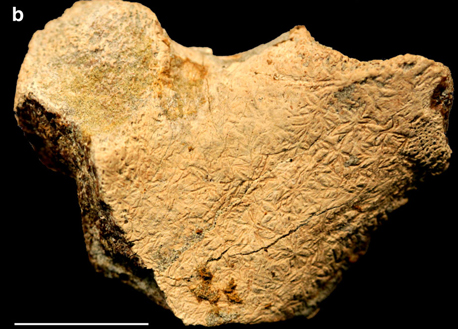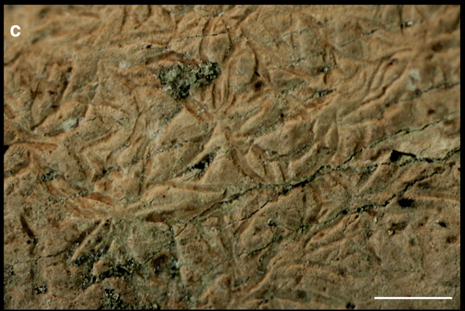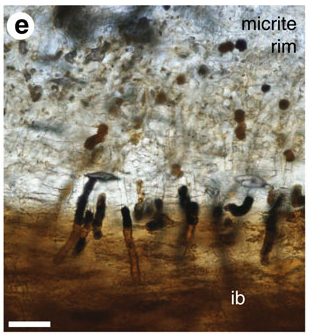What Happens when an Ichthyosaur Dies?
Scientists Explore the Miniature Ecosystem Created by an Ichthyosaur Carcase
It has been known for some time that when cetaceans (whales and dolphins) die and their corpses settle on the seabed, the carcase can sustain a diverse ecosystem for many years, even decades with the largest individuals. Palaeontologists had long suspected that the corpses of marine reptiles that patrolled the seas of the world long before the whales evolved, would have played a similar role, but until now this area of marine reptile research had not been that thoroughly investigated.
Studying Decay
Stepping up to this challenge, scientists from the Natural History Museum (London) and the Centre for Research in Earth Sciences (Plymouth University) set about mapping the evidence preserved on the fossilised bones and surrounding matrix of an ichthyosaur skeleton found in southern England.
The team concluded that although there was evidence for a succession of community feeding phases, phases which are very similar to those found in association with cetacean remains deposited in shallow water, the fossilised communities differed from those associated with whale carcases deposited in deep water environments. One phase, consisting of the establishment of a community feeding on inorganic compounds such as methane and sulphides (known as the “sulphophilic phase”) seemed to be absent according to this fossil study.
Exploring the “After Life” of an Ichthyosaur
Picture credit: Everything Dinosaur/Safari Ltd
Ichthyosaur
Ichthyosaurs were a very diverse group of marine reptiles that evolved in the Early Triassic and survived up until the Late Cretaceous (Olenikian faunal stage of the Early Triassic to Turonian faunal stage of the Late Cretaceous). Although, ichthyosaurs had the same basic, streamlined body plan, a number of families are now recognised and these reptiles, only distantly related to the Dinosauria are regarded by many palaeontologists as amongst the best adapted of all the reptiles to a marine existence.
The specimen studied was a highly disarticulated Ophthalmosaurus fossil, from Dorset. The fossil represents a three-metre-long individual from the upper part of the Ringstead Clay Member of the Sandsfoot Formation, Late Oxfordian faunal stage. We estimate that this specimen is approximately 157-156 million years old (Jurassic). The carcase came to rest on a shallow sea bed, the bones became scattered over an area of several square metres before final burial. The break-up of the skeleton was probably caused by a combination of scavenging and the action of currents, possibly high energy water flows as a result of storm activity.
Trace Fossil Evidence
The researchers identified a wealth of trace fossil evidence indicating feeding on the carcase by scavengers as well as evidence of organisms grazing on the bones themselves. Marks made by the teeth of fish were identified and the “star-shaped” feeding scratches from the ichnospecies Gnathichnus pentax were found.
An ichnospecies is an organism only known from trace fossil evidence. The strange five-pointed, star shapes etched over many of the fossilised reptile bones are very similar to the patterns made by living sea urchins with their five-toothed feeding apparatus. Scientists have interpreted these star-shaped patterns on the bones as evidence of grazing by a prehistoric sea-urchin (echinoid), G. pentax. It would have been feeding on mats of algae that had formed.
Trace Fossil Evidence on the Ophthalmosaurus Bones

Rib showing sharp, narrow grooves (white arrows) probably left by the scavenging action of small fishes.
Picture credit: Nature Communications
The picture above shows a close up of an Ophthalmosaurus rib bone showing signs of having been scavenged by small fish. The arrows indicate potential bite mark evidence (scale bar = 0.5cm).
Evidence of Grazing on the Fossilised Bones by Echinoids (Sea Urchins)
Picture credit: Nature Communications
The photograph above (b) shows the tell-tale grazing pattern of the ichnospecies Gnathichnus pentax on one of the fossilised bones (scale bar = 1cm).
A Close up of the Star-Shaped Feeding Pattern
Picture credit: Nature Communications
The Mesozoic Equivalent of a Whale Fall Incident
Commenting on the study, Richard Twitchett (Natural History Museum), one of the research paper’s co-authors stated:
“This is the first time anybody has described the ecological succession in the Mesozoic equivalent of a whale fall in detail.”
When an extant whale dies and its body sinks to the seabed, scientists have identified a number of distinct and sometimes overlapping ecological phases. First, scavengers remove the flesh and other soft tissues from the carcase. Then snails and the charmingly named bone-eating, snot-flower worms (Osedax genus) feast on the blood and the fluids from the decomposing remains.
The last phase sees the hard parts such as the bones themselves being digested by microbes which feed on the fats (lipids) stored in the bones. Tube worms live off the microbes and the likes of the bone-eating snot-flower worms persist.
Feeding by Scavengers
When the insides of the Ophthalmosaurus’s bones were examined under powerful microscopes further evidence of feeding by scavengers was found. A number of tiny, fossilised molluscs were discovered. These are associated with the same ecological community phase now associated with the bone-eating, snot-flower worms. However, there was no sign of the “sulphophilic stage”, in which oxidised inorganic compounds such as sulphides and methane, derived from microbial activity as the fats inside the bones are broken down are consumed by a chemosynthetic community. The chemosynthetic community found on the carcases of whales in deep water (greater than two hundred metres) consists of free-living bacteria and bivalves (for example, the genus Beggiatoa).
Evidence of Microscopic Scavenging Activity within the Fossilised Bone
Picture credit: Nature Communications
The picture above (e) shows a highly magnified section of ichthyosaur bone (ib) and the adjacent micrite rim represents a fine-grained calcite layer formed by the action of microbes boring into the substrate.
Mats of Microbes
Instead, the ichthyosaur’s bones were colonised by mats of microbes which attracted sea urchins and other grazing invertebrates. The bones also became the home for a number suspension feeders, such as oysters that cemented themselves to the remains of the skeleton, forming a miniature “reef phase” as described by the scientists. The remains were eventually buried entombing the remnants of the ecosystem that had been established to exploit the last resources from the dead animal.
When large cetaceans perish, a reef phase is less likely to occur as most carcases settle in deeper water and the ubiquitous bone-eating snot-flowers rapidly destroy the skeleton. The researchers conclude that shallow-water ichthyosaur falls do provide a range of ecosystem opportunities to other organisms similar to the ones seen in studies of dead whales and dolphins. However, it seems such shallow water corpses do not support any specialised chemosynthetic communities.





